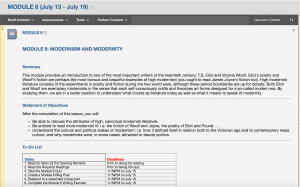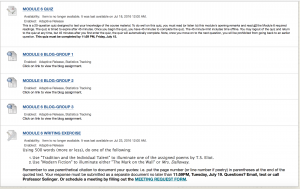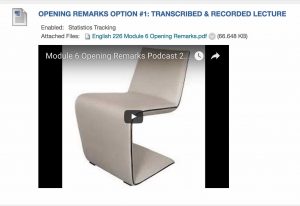Approaches to Online Student Engagement
Dr. Jason Solinger is an Associate Professor of English. He teaches Survey of British Literature online. He uses a variety of media formats to engage students in his online course. Dr. Solinger explains his inspiration and approaches in detail.
Two pedagogical questions that inform the design of my online Survey of British literature are: how can I replicate the kind of dialogue that happens in classrooms, and how can I vary the teaching and learning approaches of the online class?
Replicating Classroom Dialogue with Discussion “Blog”
The first question recognizes the challenge of incorporating collaborative learning — discussion, student-teacher dialogue, student-driven inquiry — in an asynchronous online environment. Towards cultivating this kind of learning, I use Blackboard’s blog in a couple of ways. One, I create a class-wide blog, called “the lounge,” where students can post questions regarding the coursework, the readings, and assignments. The lounge is a place where students are also encouraged to post information about community and university events, and everyone is required to introduce themselves there during the first module. A second, more curricular- centered blog is the discussion blog posted in each of my course modules. Using the student-groups function in Blackboard, I divide my class into discussion groups. In each module, students are required both to publish a blog post and to respond to one of their classmates’ posts. Sometimes I assign a question to the entire discussion group, sometimes I assign each student their own question, sometimes the inquiry is more open-ended. These group-limited discussion blogs foster the sort of intellectual community found in brick-and-mortar discussion classes, and they also put students in a position to engage each other through the collaborative analysis of a text. In one of the modules, for example, discussion-group members each answered a different question about Coleridge’s Rime of the Ancient Mariner; together, they analyzed the poem. I’m involved too, responding, coaxing, posing additional questions. My grading criterion for blog posts is different than the criteria I use to grade essay assignments. In the blog assignments, my goal is to stoke critical thinking about the texts.
Varying Teaching and Learning Approaches with Contextual Opening Remarks
The writing assignments build upon the blog assignments, and this brings me to the second question that informs my online design: how can I vary my teaching and learning approaches? This question implies another: how can I vary the course activities without making things too confusing? In the online environment, I am always concerned about students disappearing, forgetting about class assignments, missing quizzes, checking out. For this reason, every module is structured the same way, and this structural consistency makes it possible for me to vary the work that students do as well as the way I teach the material. Let me explain.

My course is divided into 7 modules, each of which opens at 12:00am on a Wednesday and closes at 11:59pm on the following Tuesday (the final module is a little longer). Designed so that students know what they need to accomplish every day of the week, each course module includes:
- a “summary” outlining the module’s concerns
- a “statement of objectives” outlining the learning objectives
- a “to-do list” outlining the module’s tasks and deadlines
- “opening remarks” contextualizing the reading and establishing interpretative questions: i.e. narrated powerpoints, musical animations, podcasts, written lectures, raw powerpoints
- a “readings” folder containing a list of the text assignments (a duplicate of the syllabus) as well as additional texts, including historical timelines and supplementary readings
- a timed “quiz”
- a discussion “blog”
- a “writing exercise”
Each course module features the same work sequence:
1) the student views, reads or listens to the “opening remarks”
2) the student completes the course reading (steps 1 and 2 may be reversed)
3) the student opens and completes the timed-quiz by 11:59pm on Friday
4) the student publishes a blog post by 11:59pm on Friday
5) the student replies to another student’s blog post by 11:59pm on Monday
6) the student submits the completed writing assignment by 11:59pm on Tuesday

As students have remarked in my evaluations over the years, this structural consistency makes it easy to keep up with the coursework, and most students complete all the required assignments. In addition to facilitating course completion, this structure requires students to work actively and consistently at a good pace; students have time to read and think about the literature, time to read and think about their peers’ insights, time to draft and revise their writing assignments. The task sequencing proceeds from less complex to more complex tasks, enabling students to develop and refine their close reading and critical analysis, culminating in a writing assignment.

Within this structure, I am able not only to vary the types of work students do but also to vary the way I teach. The “Opening Remarks,” framing the literary and cultural issues examined in the module, vary — for the sake of variety and for the benefit of different learning styles. In every module, videos and animations are captioned, and all the modules offer students additional alternatives. One of the module’s Opening Remarks comes in four different formats: a PowerPoint presentation, a musical animation, a podcast, and a lecture transcript. Students know that any version will suffice, and the idea here is to best engage all students and to give students options that work best for their daily lives. This matters most during a summer semester, when students look for online courses that they can take while traveling or working a summer job. You can listen to the podcast in your car on your way to work, but the musical animation might be watched during your lunch break.
-Dr. Jason Solinger
English
2016 WOW! Grant Recipient